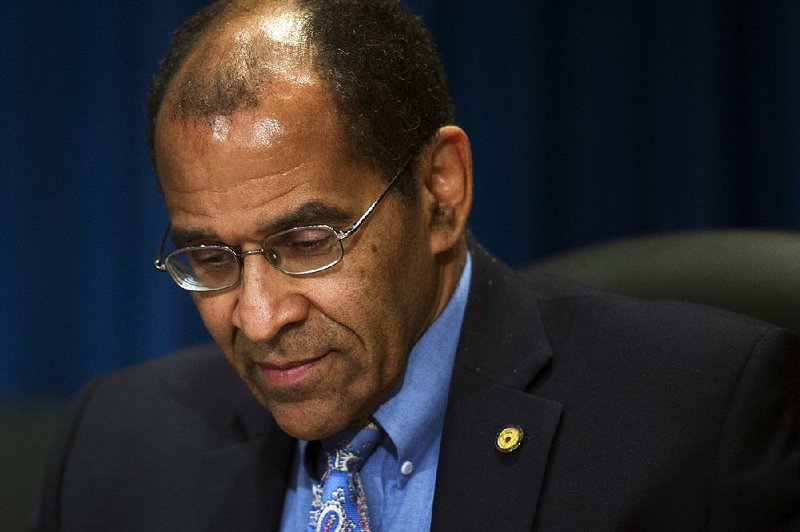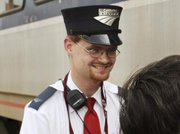WASHINGTON -- The Amtrak engineer whose speeding train ran off the rails in Philadelphia last year, leaving eight people dead, was apparently distracted by word that a train nearby had been hit by a rock, federal investigators concluded Tuesday.
"He went, in a matter of seconds, from distraction to disaster," National Transportation Safety Board member Robert Sumwalt said.
At the same time, the safety agency said a contributing factor was the railroad industry's decadeslong failure to fully install positive train control, GPS-based technology that can automatically slow trains that are going over the speed limit.
Had positive train control been in use along that stretch of track, "we would not be here today," said Ted Turpin, an investigator with the safety agency.
Engineer Brandon Bostian heard about the rock-throwing on the radio and was apparently so preoccupied by it that he lost track of where he was and accelerated full-throttle to 106 mph as he went into a sharp curve with a 50 mph speed limit, investigators said at an agency hearing to pinpoint the cause of the May 12, 2015, derailment. About 200 people aboard the Washington-to-New York train were injured.
Bostian, who has been suspended without pay since the crash, did not attend the hearing. He and his lawyer did not immediately return calls and emails seeking comment.
Ron Kaminkow, an Amtrak engineer who serves as secretary of the industry union consortium Railroad Workers United, said the board's conclusion underscores the need to put two engineers on trains.
"If one buys into this theory, having another engineer or conductor would've prevented the wreck," he said.
As for what this could mean for Amtrak and Bostian, the railroad has already taken responsibility for the tragedy, and its liability is capped under federal law at $295 million, which could easily be exhausted, given the number of deaths and serious injuries.
The Philadelphia district attorney's office is helping the safety agency on the investigation, but a spokesman would not comment on the possibility of criminal charges.
The hearing included a discussion over how much blame to assign to the lack of positive train control. In the end, the safety agency cited that as a secondary factor.
But the agency's chairman, Christopher Hart, warned that unless the technology is put fully in place, "I'm very concerned that we're going to be back in this room again, hearing investigators detail how technology that we have recommended for more than 45 years could have prevented yet another fatal rail accident."
Among other things, the safety agency recommended research into train seat belts and ways to secure luggage, which can become missiles in a derailment; training for crew members on multitasking; and new equipment and procedures to help engineers keep track of their location in spots where there is no positive train control.
In a statement, Amtrak said it "deeply regrets the tragic derailment" and will carefully review the agency's findings and recommendations and quickly adopt them where appropriate. Amtrak noted that positive train control is already in place on most of its portion of the Northeast Corridor.
The problem of people throwing rocks at trains is so common that train crews have a term for it: "getting rocked." But it is a danger that railroads are almost powerless to stop. No one was arrested in the rock-throwing in Philadelphia.
Bostian told investigators that just before the wreck, he was listening to radio traffic from a Philadelphia commuter train operator who said a rock had shattered his windshield. At one point, Bostian passed the commuter train on an adjoining track.
He told the safety agency that he was concerned about the welfare of the commuter train's engineer and "a little bit concerned" for his own safety, but he never indicated his own train had been struck, too. The agency concluded it wasn't hit, despite early suspicions triggered by a dent discovered in Bostian's windshield.
Investigators said they believe Bostian was accelerating because he thought he had already passed the sharp Frankford Junction curve. After the curve is a straightaway where the speed limit climbs to 110 mph.
Authorities ruled out cellphone use on Bostian's part, as well as drugs or alcohol.
Bostian told investigators that he couldn't remember some of what happened that night -- probably because of a blow to the head suffered when his locomotive overturned, said safety agency medical officer Mary Pat McKay.
Thomas Kline, a lawyer for passengers injured in the crash, questioned the safety agency's findings and said he wonders whether the engineer sped up to get through the area quickly and avoid "getting rocked."
Duy Nguyen, of Teaneck, N.J., a passenger who suffered a cut on his head and fractures in his back, attended the agency's hearing. The Temple University professor said he was puzzled by the findings.
"The part that doesn't make sense is how does one accelerate when you're distracted?" Nguyen said. "The inclination is to slow down."
Information for this article was contributed by Maryclaire Dale and Errin Haines Whack of The Associated Press.
A Section on 05/18/2016

